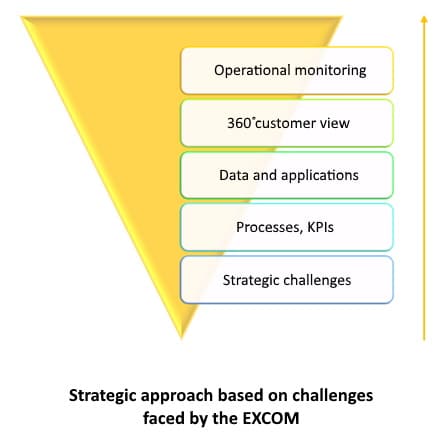After having emphasised the importance of rooting CRM projects in a strategic vision and auditing the available (and required) data capital, we broaden the scope of discussion to include the major changes that companies must undergo to remain competitive today, namely with respect to what we have termed “internal culture,” one of our 3 CRM and Marketing digital project pillars. Today, we will focus on how to optimise return on investment on CRM projects.

This series of three articles presenting our current vision for Customer Relationship digital projects should result in the launch of a new approach to manage the Customer information system intended for sales teams.
What manager has not, 18 months or more after implementing a CRM system for its sales team, wondered whether the investment had finally paid off? Whether it had really helped improve conversion rates, turnover, margins or internal costs?
Many sales teams today are equipped with Customer Relationship Management (CRM) software; however, it is worth noting that more than the tool, sales performance is first and foremost a function of business process, organisation and goal setting. Simply put, it is our experience that no CRM project, implemented without a relevant and driven business process will ever generate a satisfactory return on investment. At best, it will merely facilitate the preparation of sales representatives’ visits by giving them quicker access to Customer data.
Focus on the issues to be addressed
That is why, as we explained in our “CRM and Artificial Intelligence: how to develop and optimise your data?” article, CRM implementation projects should be fuelled by focused thinking on the challenges to address, as illustrated below.Contrary to what is frequently observed, where people almost immediately start configuring the software to describe customers and opportunities in a detailed manner.

The advantage of this method is that it helps keep in mind, throughout the whole project, the real goals behind the implementation effort. Its aim is to get you to think along the lines of Pareto’s law and dismiss, during the first phase, everything that is not directly helping you meet objectives, by, for example, focusing on the 20-30% data necessary to satisfy 70-80% of your analysis and management needs.
Ensuring operational readiness of CRM tools
Most CRM tools in use today have been in place for a number of years already and have, over time, become more complex due to the addition of new features, specific developments complementing standard features to modify its behaviour or changes in orientation.For instance, the use of the prospect/lead/opportunities trio is often subject to debate and change along the way.
Consequently, maintaining the tool in operational condition, updating it regularly (patches or vendor upgrades), rolling it out to new user profiles… has become an increasingly complex and costly endeavour. As a result, we tend to either push back deadlines to manage development batches in “project mode” (or in the case of Microsoft’s CRM, to migrate from an on-premise version to an online version) or we try to increase the number of intermediate releases in order to limit the risks, with non-regression testing automation then becoming a requirement.
Moreover, we evolve today in a highly competitive environment where maintenance costs are regularly revised and technological innovation is constantly creating new opportunities that are seized by competitors. The time has thus come for a paradigm shift regarding CRM tools and more generally, Customer Relationship platforms designed for sales teams.
These platforms should indeed, be in line with the 3 key areas of internal culture that we recommend:
- Be easily upgradeable, both in terms of features and capability. There lies the strength of SaaS solutions today, providing one does not stray too far from the standard versions.
- Generate quality data to consolidate the company’s analytical and forecasting abilities with each passing day.
- Provide continuous support to users through the integration of recommendations and guidelines within the correct Customer/Process/User context.
Committing to a dynamic vision of the information system
In plain terms, we recommend that companies that already have their own customer relationship platform commit today to a dynamic vision of their customer information system and rely on the following 4-step multiannual support programme to increase sales performance:
- An audit of the current customer relationship platform to assess its strengths and weaknesses in light of the business context.
- A Customer Relationship Management (CRM) tool project that will help it recover its fast development capabilities and enable monitoring.
- The implementation of a strong performance driver to quickly yield a new return on investment and create a momentum for change (tactical rebound).
- Continuous improvement of business performance through the management of a portfolio of technological innovation levers. Continuous improvement is only possible if the multiannual support rests on 3 independent pillars, under unique management, in direct connection with business functions: CRM tool monitoring services (for instance: the way the tool is used by users, data quality, multichannel availability…), ongoing maintenance services (support, correction and upgrade) and innovation services (for example: innovation watch, training, KPI-based evaluations, technology testing and MVPs or Minimum Viable Products development, rapid standardization processes…).

This is the background against which we think it possible to come up with a new offering for CRM customers that will revolutionise the Third-party Application Maintenance (TPM) field. One that would target organisations having an integrated Microsoft CRM solution and wishing to optimise the return on investment for work already carried out.















![[EXPERT DISCUSSION] Artificial Intelligence in 7 key points](https://en.blog.businessdecision.com/wp-content/uploads/2017/06/debat-intelligence-artificielle.jpg)
Your email address is only used by Business & Decision, the controller, to process your request and to send any Business & Decision communication related to your request only. Learn more about managing your data and your rights.